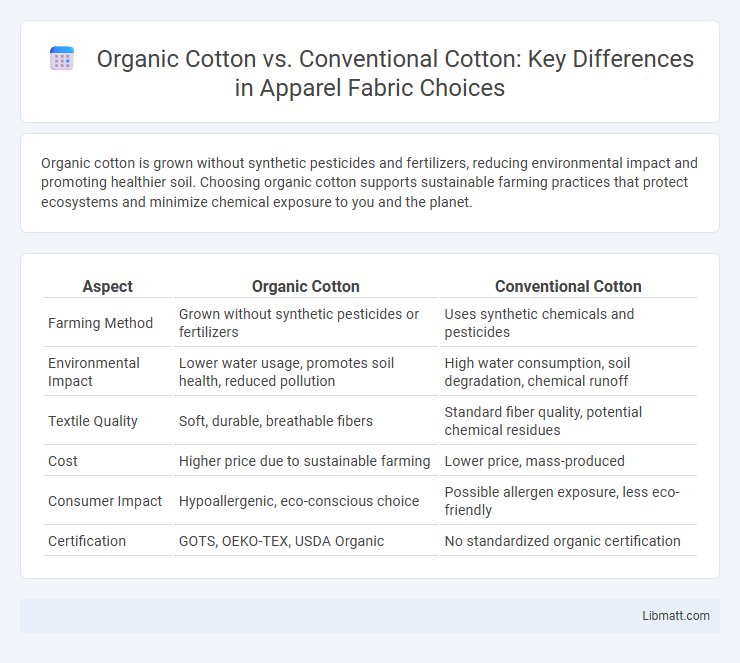Organic cotton is grown without synthetic pesticides and fertilizers, reducing environmental impact and promoting healthier soil. Choosing organic cotton supports sustainable farming practices that protect ecosystems and minimize chemical exposure to you and the planet.
Table of Comparison
| Aspect | Organic Cotton | Conventional Cotton |
|---|---|---|
| Farming Method | Grown without synthetic pesticides or fertilizers | Uses synthetic chemicals and pesticides |
| Environmental Impact | Lower water usage, promotes soil health, reduced pollution | High water consumption, soil degradation, chemical runoff |
| Textile Quality | Soft, durable, breathable fibers | Standard fiber quality, potential chemical residues |
| Cost | Higher price due to sustainable farming | Lower price, mass-produced |
| Consumer Impact | Hypoallergenic, eco-conscious choice | Possible allergen exposure, less eco-friendly |
| Certification | GOTS, OEKO-TEX, USDA Organic | No standardized organic certification |
Introduction to Cotton Varieties
Organic cotton is grown without synthetic pesticides and fertilizers, promoting environmental sustainability and soil health. Conventional cotton relies heavily on chemical inputs, resulting in higher yields but increased ecological impact. Choosing organic cotton supports a healthier ecosystem and reduces your exposure to harmful chemicals.
What is Organic Cotton?
Organic cotton is grown without synthetic pesticides, fertilizers, or genetically modified organisms, promoting healthier soil and ecosystems. It uses natural farming methods that conserve water and reduce environmental impact compared to conventional cotton, which relies heavily on chemical inputs. Choosing organic cotton supports sustainable agriculture and reduces your exposure to harmful chemicals in textiles.
Understanding Conventional Cotton
Conventional cotton is grown using synthetic pesticides, herbicides, and fertilizers that often lead to soil degradation and water pollution. It accounts for about 90% of global cotton production, relying heavily on chemical inputs to increase yield and pest resistance. This intensive farming method contributes significantly to environmental damage and poses health risks to farmworkers.
Environmental Impact: Organic vs Conventional
Organic cotton farming significantly reduces environmental impact by avoiding synthetic pesticides and fertilizers, promoting soil health, and conserving water resources compared to conventional cotton, which relies heavily on chemical inputs and extensive water usage. Organic methods support biodiversity and decrease pollution in surrounding ecosystems, whereas conventional cotton cultivation often leads to soil degradation and contamination of water bodies. Studies show organic cotton uses up to 91% less water and generates substantially lower greenhouse gas emissions, making it a more sustainable option for textile production.
Health and Safety Considerations
Organic cotton is cultivated without harmful pesticides and synthetic fertilizers, reducing your exposure to toxic chemicals and promoting healthier soil conditions. Conventional cotton farming often involves extensive use of agrochemicals, which can accumulate on fabrics and pose skin irritation or allergic reactions. Choosing organic cotton enhances both personal health and environmental safety by minimizing chemical residues and supporting sustainable agricultural practices.
Farming Practices Compared
Organic cotton farming eliminates synthetic pesticides and fertilizers, relying instead on natural pest control, crop rotation, and composting to maintain soil health and biodiversity. Conventional cotton farming often depends heavily on chemical inputs and monoculture planting, which can lead to soil degradation, water pollution, and reduced ecosystem resilience. These differing practices significantly impact soil quality, water usage, and environmental sustainability in cotton production.
Economic Factors and Costs
Organic cotton typically incurs higher production costs due to the use of natural fertilizers and pest control methods, which can limit yield but enhance sustainability. Conventional cotton benefits from established infrastructure and higher yields, resulting in lower immediate costs but often involving environmental externalities not reflected in market prices. You may find organic cotton priced higher upfront, yet it supports long-term economic benefits through soil health preservation and reduced dependency on synthetic inputs.
Quality and Performance Differences
Organic cotton typically offers superior softness and breathability compared to conventional cotton, due to the absence of chemical pesticides and fertilizers during cultivation. The fibers of organic cotton tend to be longer and stronger, enhancing fabric durability and comfort for Your clothing. Conventional cotton may have higher pesticide residues and less environmental impact, but often sacrifices some quality and natural feel found in organic options.
Certification and Labeling Standards
Organic cotton is certified under strict standards like GOTS (Global Organic Textile Standard) and OEKO-TEX, ensuring sustainable farming practices and chemical-free processing. Conventional cotton lacks these certifications, often involving synthetic pesticides and fertilizers that can harm the environment. Labels such as GOTS or Organic Content Standard (OCS) provide consumers with verified guarantees of authenticity and eco-friendly production.
Making an Informed Choice
Choosing between organic cotton and conventional cotton involves understanding key differences in environmental impact and health considerations. Organic cotton is grown without synthetic pesticides and fertilizers, reducing soil degradation and water contamination, while conventional cotton relies heavily on chemical inputs that contribute to pollution and biodiversity loss. Evaluating factors such as water usage, carbon footprint, and labor practices helps consumers make a sustainable and ethical decision aligned with environmental responsibility and personal health.
Organic Cotton vs Conventional Cotton Infographic

 libmatt.com
libmatt.com